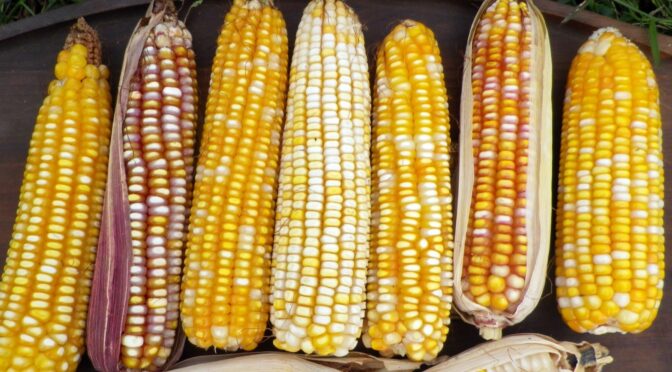In a previous post, we gave you 22 reasons to save seed in 2022. We hope that all of our customers are considering saving some seed this year. If you’re new to seed saving, one crop that’s great for beginners is corn. Whether you’re growing sweet corn, flour corn, Gourdseed corn, or popcorn, saving corn seed is simple! It’s an easy-to-grow annual, and its large seeds are easy to process and store.
Selecting a Variety
When selecting a corn variety, whether you’re growing sweet corn, popcorn, or flour corn, you need to choose an open-pollinated variety. These are seeds that were pollinated by other plants of the same variety. This means that as long as you keep them isolated from other varieties, they will keep producing true to this variety year after year. All heirlooms are open-pollinated.
Hybrids are seeds that are the result of a cross between two varieties. Typically seed saved from hybrids will not produce plants that are the same as the parent plant.
Sweet Corn hybrids are the only hybrid varieties we carry at SESE. We have a couple of hybrid sweet corns because some of the farmers and market gardeners who purchase our seed prefer the uniformity and reliability of these hybrids. However, they’re not suitable for seed saving.
Plan Your Garden for Saving Corn Seed
Unlike most garden vegetables that rely on insect pollination, corn is a wind-pollinated crop. Pollen is carried from the tassels of corn stalks to the silks on other stalks by the wind. Each silk connects to a potential kernel (a plant ovule). If you’ve ever had corn that didn’t produce many kernels, it’s because they weren’t fertilized.
When you plan your garden’s layout, you want to ensure that the corn you intend to save seed from is separated from other varieties by 600 feet for home use or one mile for pure seed.
Select Your Best Plants
When you save seed year after year, you have the ability to improve a variety. You can select for a variety of plant characteristics. You can select for traits like flavor, earliness, disease resistance, and drought tolerance if you save seed from the plants that perform the best.
Let Your Corn Fully Mature
When harvesting corn for seed, it’s essential to let the corn fully mature and dry on the plant. The husk and stalks should be papery and brown. The silks should be dry and brown. When you harvest, the kernels should feel hard and dry. You shouldn’t be able to puncture them with a thumbnail. Sweet corn kernels should have a wrinkled appearance.
Harvest Your Seeds
You want to ensure you’re saving enough to maintain genetic diversity when you harvest seed. Save at least 500 seeds from at least 10% of the plants to maintain the vigor and genetic diversity of the variety.
Dry Your Ears
Most corn should be dried further after harvesting to ensure mold doesn’t develop in storage. You’ll want to dry your corn somewhere out of direct sunlight.
You can do this in a few ways. One option is to pull back the husks but not remove them. They can be hung from the husks separately or braided into bunches. You can also remove the husks entirely and hang the cobs in mesh bags. It’s a good idea to shake the bags around every couple of days to ensure all the cobs are drying evenly. Lastly, you can lay the cobs out on a rack or screen. Large screens can be made using lumber and chicken wire or hardware cloth.
Process Your Seeds
Corn seed is easy to process. To remove the kernels, you can use your hand and twist it over the kernels. You can also use a corn sheller to make this process easier on your hands.
Though it isn’t strictly necessary if your corn is just for seed use, you can winnow out any chafe (plant material). To do this, place a box fan on a chair or stool with a bucket in front of it. Then, with the fan on, dump your corn seed into the bucket. The fan should blow away the lighter plant material while the kernels fall into the bucket. You may have to do this several times to remove all the chafe.
Store Your Seeds
Once your seeds are fully dry and clean, you can store them in airtight containers. Mason jars work well for this. Keep them somewhere cool and dark until you’re ready to plant them next season!
Learn how to do a germination test in this post, Seeds: Tips for Storing, Testing, & Saving.
Using these eight simple steps, you can save seed from your corn crop! To learn more about saving seeds from other crops, check out these posts: Easy Seed Saving with Promiscuous Pollination, 7 Steps to Saving Cucumber Seed, 6 Steps to Saving Pumpkin Seeds, Seed Saving from Biennial Crops, and Seed Saving for Beginners.




